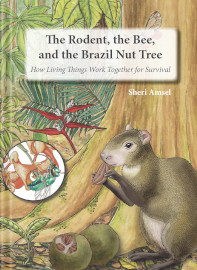The Rodent, the Bee, and the Brazil Nut Tree: How Living Things Work Together for Survival is a beautifully illustrated story of the mutualism among Brazil nut trees, orchid bees, helmet flower orchids, and large rodents called agoutis, all of which live together in the Amazon rainforest.
Deep in the Amazon jungle is the only place Brazil nut trees grow. But they are only able to grow there because of the presence of orchid bees, which will only mate where beautiful, smelly helmet flower orchids are found. And large rodents called agoutis are essential because they are the only animal that can crack the tough Brazil nuts to eat and spread the seeds.
As with so many other mutual ecosystems, this one is delicately balanced with interdependent species that are at risk as more and more of the rainforest is destroyed.
Author Sheri Amsel follows the story with some activities to expand and reinforce learning. The first activity teaches how different life forms interact as Amsel explains mutualism, commensalism, and parasitism with text and illustrations. This broadens learning beyond the mutually beneficial relationships in the story. Other activities include games, drawing, research, poster making, composing a pictorial journal, and solving a hidden-pictures puzzle. (You can access many of the activities for free through the publisher’s website.)
Two other free PDFs can be downloaded from the publisher’s website. A seven-page guide titled NGSS Curriculum Guide for The Rodent, the Bee, and the Brazil Nut Tree lists which of the Next Generation Science Standards are covered and the expected learning outcomes. It also has one page with more information to read aloud to students plus two activity pages with answer keys. The other PDF on the publisher’s website has five activity pages that involve rainforest wildlife identification, coloring, a dot-to-dot puzzle, a maze, and hidden images. It’s easy to miss these extra resources!
The story should work as a read-aloud book for grades K-5. Older students up through eighth grade might read it on their own. Some of the activities in the book and the supplemental PDFs are great for all ages, while a few are best for younger students up through about fourth grade.
Summary
The scientifically detailed, full-color drawings in the book are fascinating to look at, and the story explains the mutual dependence of living organisms in a way that even young children can understand. The book is very useful on its own, and the inclusion of the varied activities makes it even more valuable for homeschooling families.









